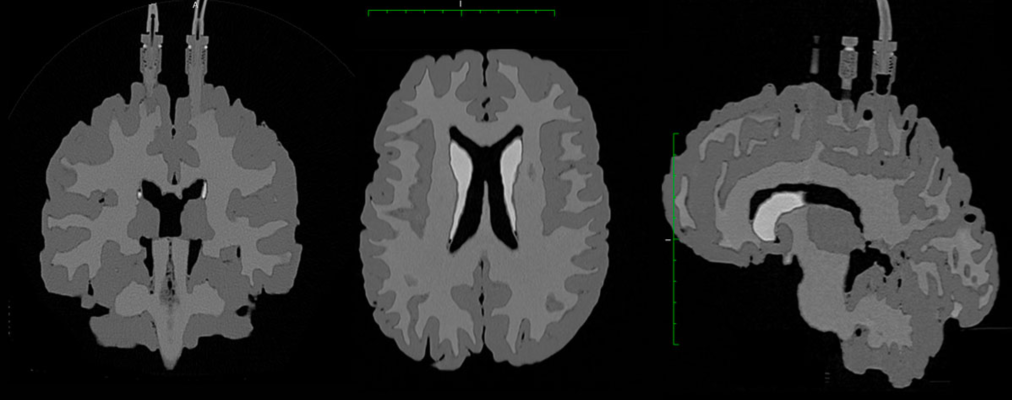About
Human Shape Technologies is an innovative startup established on May 21, 2021, with the aim of carrying out the StepBrain technology transfer project, winner of the POR FESR 2014-2020 - CAMPANIA STARTUP 2020.
The company provides many years of expertise in the fields of radiological medicine, medical physics, biomedical and electronic engineering for the creation and manufacture of anthropomorphic phantoms - even customized ones. Specific skills are expressed through ad-hoc software development for medical image processing, anatomical modelling, design, and 3D printing.
StepBrain Project
The project aims at the technology transfer of an anatomical phantom of the human brain, called Step-Brain, made thanks to an innovative 3D printing technology.
In Diagnostic Imaging, anthropomorphic phantoms perform the function of characterization and verification of the equipment in the various clinical imaging methods, as in Positron Emission Tomography (PET) and Single Photon Emission Tomography (SPET [or SPECT]). Furthermore, phantoms are often used to fine-tune the techniques to perform diagnostic tests in total safety, since they are able to return results very similar to those obtained on real patients.
Project description
StepBrain is an anatomical phantom of the human brain made thanks to an innovative 3D printing technology. The StepBrain phantom was designed to simulate the biophysical and pathophysiological conditions of human brain tissues with the aim of optimizing the interpretation of diagnostic imaging tests performed for the diagnosis and monitoring of neurodegenerative diseases, such as Alzheimer's disease. The use of this innovative brain phantom will help increase knowledge of this type of pathology, and therefore improve the longevity and quality of life of patients suffering from neurodegenerative diseases.


Coronal, axial, and sagittal sections of the Step-Brain prototype obtained through CT with contrast medium.

Aim
The aim is to improve the interpretation of brain studies on patients using Nuclear Medicine methods such as Positron Emission Tomography (PET) and Single Photom Emission Computed Tomography (SPECT). Moreover, given its high resolution, obtained thanks to a sophisticated 3D printing technique, it is the only marketed phantom suitable for the characterization of hybrid diagnostic scanners with Magnetic Resonance (MRI) and Computed Tomography (CT [or TAC]), or scanners hybrids PET-MRI, PET-CT, and SPET-CT. The latter constitute the frontier of Diagnostic Imaging, as they synergistically provide both the morphological and functional information of the patient, which cannot be obtained simultaneously with the single traditional methods.
Main product advantages
The main advantages of Step-Brain, compared to the state of the art of brain phantoms, are represented by the possibility of:
- Simulate all existing types of static diagnostic studies involving the main brain compartments studied in Nuclear Medicine, namely Gray Matter, White Matter and Striated Matter. This is thanks to the characteristic of the Step-Brain of being made up of separate compartments that can be filled with the appropriate radioisotope solutions. On the other hand, in the phantoms at the current state-of-the-art, either the Gray and White Matter compartments (phantom by Hoffman), or the Striatum (phantom by Alderson) can be simulated exclusively.
- Perform brain studies involving the use of high-resolution scanners (hrPET, CT and Magnetic Resonance). This is because the internal walls of the Step-Brain are of an average thickness of less than 1 mm. While in the state-of-the-art of brain anatomical phantoms (Hoffmann phantom), the minimum thickness of the acquired layers cannot go below 6 mm in thickness.
- Quantize and correct the partial volume effect (PVE), a typical defect of Emission Tomography in PET and SPET examinations. This is thanks to the high resolution of the Step-Brain and its usability in Magnetic Resonance, which is impossible for the other existing phantoms.

Bibliography
Pirozzi MA, Gaudieri V, Prinster A, Magliulo M, Cuocolo A, Brunetti A, Alfano B, Quarantelli M
StepBrain: A 3-Dimensionally Printed Multicompartmental Anthropomorphic Brain Phantom to Simulate PET Activity Distributions.
Journal of Nuclear Medicine July 18, 2024, jnumed.123.267277; DOI: 10.2967/inumed.123.267277 - ISSN 0161-5505
